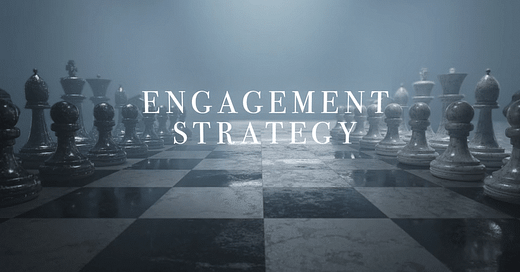Strategy: Why you need one
It goes without saying that every serious and successful content creator has at least some kind of strategy, along with a strong brand.
If you want to be effective in your engagement endeavours you need to proceed with purpose. You need to understand what it is you’re doing, why you’re doing it, and how to measure if you’re doing it well.
And, much like your research projects, taking the time to set out a plan before you fully commit to your creative engagement journey will save you time, and pain and suffering, along the way.
So,
Step One: Goals and audience
Figure out your goals and audience.
What do you need to achieve? and Who is this for?
Much like a research proposal, consider the aim and the objectives for your creative engagement. Be as specific as possible about the purpose of your creative content.
To achieve the aim and objectives, determine the audience that your content needs to connect with. While it can be tempting to think “everybody!”, that’s never the case.
Your audience needs to be specific.
Step two: Distribution
Your chosen distribution channel or publication platform will be determined by your audience and the type of content that you will create.
If your objective is to raise your profile and demonstrate thought leadership within your field or industry, nobody’s going to just stumble across your videos on YouTube.
If your objective is to contribute to and lead public discourse in your field, engaging with an existing audience that is already talking about your topic, or adjacent topics, it is unlikely your professional network on LinkedIn will be as jazzed as these people.
So, you need to choose the right platform to engage on1.
Step three: Get creative
Develop your content. Find guiding structures and script prompts that work for you, and think back to the video identity exercise.
Embrace creativity and authenticity, and experimentation. You’re making these videos, either by yourself or with a video producer, so take the opportunity to present your research and tell your story in a way that is true to you. And, hopefully, in a way that will connect with your audience.
What gets you excited?
Anecdotally, one of the key factors to success for content creators is enthusiasm. Think about it, if you aren’t enthusiastic about your research nobody else will be.
Basically, this step just says make something.
Step four: Analysis
Return on investment is important. Creative content takes resources, including the investment of time and sometimes money. So, be accountable for your actions. This is essential if you want buy-in from your institution.
After a video has been made and published, undertake both quantitative and qualitative analysis.
Regardless of platform, calculate the videos engagement (likes, comments, shares) and the views (YouTube) or impressions (LinkedIn).
Work out your engagement rate: likes + comments + shares ÷ views/impressions x 100 = engagement rate.
Anything higher than 2% is considered decent engagement on LinkedIn. On YouTube and TikTok, you’re looking for something higher than 4%2.
Doesn’t sound too hard, does it?
And reflect on your aim and objectives. Have your creative endeavours contributed in some way to your success?
Figure out what works and do more of it.
Step five: Keep going
Assuming the process is rewarding and you’re satisfied with the output, and the content you’re producing is actually pretty good, one of the keys to success is consistency.
Sustained engagement is critical to raising your profile, growing an audience, and positioning yourself as a thought leader in your field.
So, show up.
Share your work.
Be seen.
And be heard.
Step 1. Figure out your goals and audience
Step 2. Determine your distribution channel and the types of content that performs well
Step 3. Develop your content, embrace authenticity and creativity and try different things
Step 4. Analyse and evolve: how has your content performed? Find what works and do more
Step 5. Keep making content! Consistency and sustained engagement are critical
The end: thanks for following along
So, that’s about it.
But is it really?
Absolutely not.
This is just the start.
The basics.
Now, it’s about carving out your own path and commencing your own creative journey.
Now, head back to the start or go grab a camera and get creating
Since you made it this far, why not connect with me on LinkedIn?
You can engage across multiple platforms, but it is advisable to pick just one to start. When that is established, and you’ve found a good rhythm, expand your engagement across other platforms.
What’s considered good engagement goes down the bigger your audience. So, if you’re a creator with hundreds of thousands of subscribers, even a 1.5% engagement rate is considered good. If we think about that, it still means around 1500 people engaged with the content, which is still a lot.




